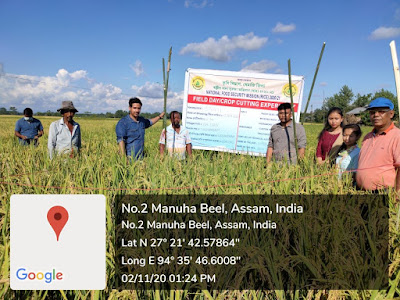As
extension personnel have publicly argued, the communication gap between extension and
farmers has widened since the extension reforms (ZREAC Kharif-ZREAC for UBZ, Proceedings,2020).
Indeed, it was government policies and programmes that worsened the chasm. In
Assam, 54% of farmers lacked access to information, while 30% received right
ADO/VLEW (NSSO,2013). Based on primary and secondary data, some policy-level
suggestions that strengthened government policies may help avert future crises.
Image: Successful demonstration of a 'Recommended Technology' by an ADO
The organisation's current challenges...
- Over 40% of field-level staff positions still need to be filled.
- As of 01.04.2020, 256 Director to ADO positions remains vacant out of 930 total. Out of 33 districts, only 28 District Agriculture Officer positions are vacant.
- Due to many vacancies, numerous ADOs and VLEWs are assigned 2-3 circles/leaks.
- The post-T&V scheme needs a clear job description for ADOs and AEAs.
- ADOs perform a variety of tasks outside their domain throughout the year.
- ADO and AEA have no scheduled official visits to meet with farmers.
- ADO/AEA does not have an official job description.
Policy recommendation:
-Increase the rate at which vacant positions are filled (Recently, the government started to fill up the vacant post. In 2023, the situation is immensely improved for human resources)
-There
is an immediate need to develop job descriptions for all cadres
that reflect
agriculture's current state.
The organisation's current challenges...
- Extension officers help government programmes targeted toward beneficiaries, and their services are limited to the beneficiaries and the programme
- Extension personnel are perplexed by the term "recommended technology."
Recommendation for Policy
-Associating
extension personnel with all other responsibilities is critical,
as agriculture
is a time-sensitive activity.
-Considering
the competitive market environment, the department
should prioritise who or how
technology will be recommended.
The
organisation's current challenges...- ATMA's performance is deficient.
- ATMA is being piloted with the help of temporary field-level extension staff.
- ATMA is still running on an ad hoc basis.
- The organisation continues to run the post-T&V system to work as the central public extension service provider.
-Evaluate the ATMA model's feasibility, which has been in experimentation since 2005.
The
organisation's current challenges...
- There is no opportunity for advanced agricultural sector building capacity and no refresher training to keep knowledge current.
- There needs to be more information available to extension personnel.
- The average age of extension personnel is more than 50 years.
- The Directorate of Horticulture was created without creating positions.
Recommendation for Policy
-Infrastructure
for the flow of information from various sources must be
set up at the DAO/SDAO
level.
-Within the Directorate of Horticulture, new jobs should be created and returned to the attached officers of the Agriculture Department.
The organisation's current challenges...
- Inadequate space for ADO offices
- Without FMCs, ADO/AEA service is affected.
- Extension services are not financially supported.
-The Office may be set up with Development Block.
-Maintain a budget to support the cost of routine extension services, which are not covered by any schemes.
(Opinions are the author’s personally
prepared based on observation and primary and secondary data)




Very nice Sir
ReplyDeleteThank you so much sir for sharing all this wonderful info
ReplyDelete